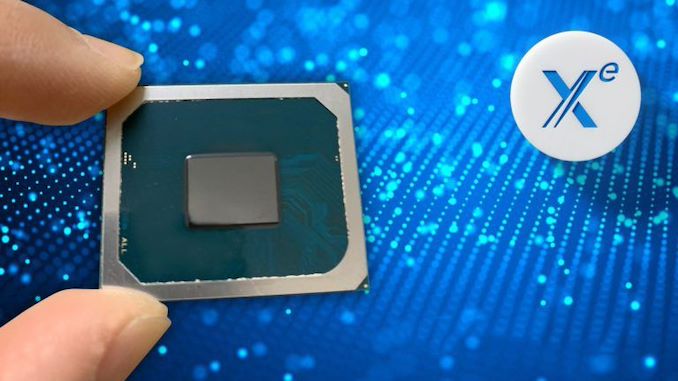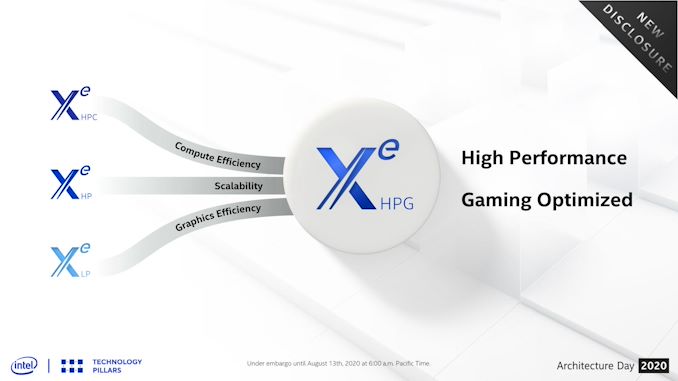Intel: DG1 GPU Now Shipping, Xe-HPG DG2 GPU In Labs
by Ryan Smith on October 22, 2020 9:30 PM EST
Alongside today’s profitable-but-uneasy earnings report from Intel, the company’s earnings presentation also offered a short update on the status of their discrete GPUs. As of today, Intel’s DG1 GPU is now shipping. Meanwhile the company announced their next GPU, appropriately named DG2, which is based on their upcoming Xe-HPG architecture. This GPU is now back from the fab and is in Intel’s lab, and is now far enough along to have been powered on.
First and foremost we have DG1, or as it’s better known by its commercial product name, Iris Xe Max. Intel’s first discrete GPU in over two decades, the company has since the beginning of this year been touting it as a companion to their Tiger Lake CPUs, pitching it as an upgraded graphics option for thin & light notebooks, and a successor of sorts to Intel’s GT3e and GT4e iGPU configurations from past generations. Until recently, we weren’t quite sure when it would show up in commercial products, but recent OEM notebook reveals along with Intel’s earnings announcement are now confirming that the GPU is shipping to OEMs. According to Intel, DG1-equipped notebooks are expected later in Q4. In the meantime, there are still scant few details on DG1 itself, such as expected performance and power consumption; so hopefully Intel will be getting ahead of its OEM partners on this one to set some expectations.
Meanwhile, today’s notes also announce for the very first time the next discrete GPU to come out of Intel, DG2. While obviously still some time off, Intel has completed tape-out and fabbing of the initial alpha silicon, with the company reporting that they’ve powered-on the GPU in their labs.
Somewhat surprisingly, CEO Bob Swan has also confirmed that this isn’t just a DG1 successor, but instead is a higher performing GPU based on the company’s forthcoming Xe-HPG(aming) architecture. First revealed this summer, Xe-HPG is Intel’s enthusiast/gamer-focused architecture, incorporating marquee features found in similar dGPUs like ray tracing. It’s also being manufactured completely external of Intel; while the company hasn’t said which fab and process node is being used, it’s none of Intel’s nodes. So this is the first major piece of external fabbed silicon that we know of to be up and running at Intel.
But like all teasers/financial disclosures, Intel isn’t saying too much more at this time. Nothing new was revealed about the Xe-HPG architecture, and Intel hasn’t clarified whether DG2 is a big, flagship-grade chip, or a more modest, high-volume part. For now, the company is simply saying that DG2 will “take our discrete graphics capability up the stack into the enthusiast segment.”
Source: Intel












50 Comments
View All Comments
Machinus - Friday, October 23, 2020 - link
I'm "shipping" a GPU also. Trust me.edzieba - Friday, October 23, 2020 - link
"Iris Xe Max"C'mon guys, don't name the product at the bottom of your performance stack 'max'!
sing_electric - Friday, October 23, 2020 - link
Well, it's Iris Max. I don't know if the plan is that all discrete parts will be Iris Max then a product number (so "Iris Max" is the equivalent of "GeForce," or "Radeon"), or it's just to denote that it's the top of the stack for Intel laptop graphics.If you think "Iris Max" sounds dumb, I agree, but so does GeForce, so...
Fergy - Friday, October 23, 2020 - link
For the last 30 years you didn't choose an Intel GPU. You got it for free and kept it if it was good enough. I've never been happy to have to use an Intel GPU. Always 3 to 4 years behind to where they should be.PeachNCream - Friday, October 23, 2020 - link
That depends on your needs really. Since the GMA950, I've been satisfied for the most part with Intel's graphics performance and have been really happy with the HD 3000 and newer for mundane computing tasks and various low demand games that I know will work well on whatever iGPU comes with the laptop or desktop. Not having the cooling, power demand, or costs associated with a dGPU helps quite a bit, but you do have to adjust your expectations and workload.Spunjji - Friday, October 23, 2020 - link
Indeed. As a gamer I bag on Intel plenty for their GPUs, but in the timeline you mentioned they went from "oh god please no" to "hey, I can play quite a few games on this".Murloc - Friday, October 23, 2020 - link
they've been good enough for work and light gaming for years now.Oxford Guy - Friday, October 23, 2020 - link
Nvidia and AMD have been peddling ancient GPU tech at the low end for years.It would be a nice change to not see MicroCenter selling 8400GS cards and GeForce 210s.
A bit more competition might prompt both companies (or at least one of them) to stay current at the low end.
lmcd - Friday, October 23, 2020 - link
I'd be excited to see Intel at the low end, because there's a better chance of a cheap card with good encode/decode blocks. I'd also be excited for the potential for virtualized graphics. Even if the wonderful slice-assignment virtualization goes away for consumer (which it probably won't), AMD has botched its UEFI implementation for literally 3+ years, and Nvidia explicitly disables virtualization (in Windows guests) in its GeForce line.Intel could revolutionize GPU virtualization for consumers. Sure, it's a small market, but there's reasons to like Intel in this space.
JayNor - Tuesday, February 9, 2021 - link
Raja posted an image from a Xe-HPG mesh shader test today, so apparently not dead.